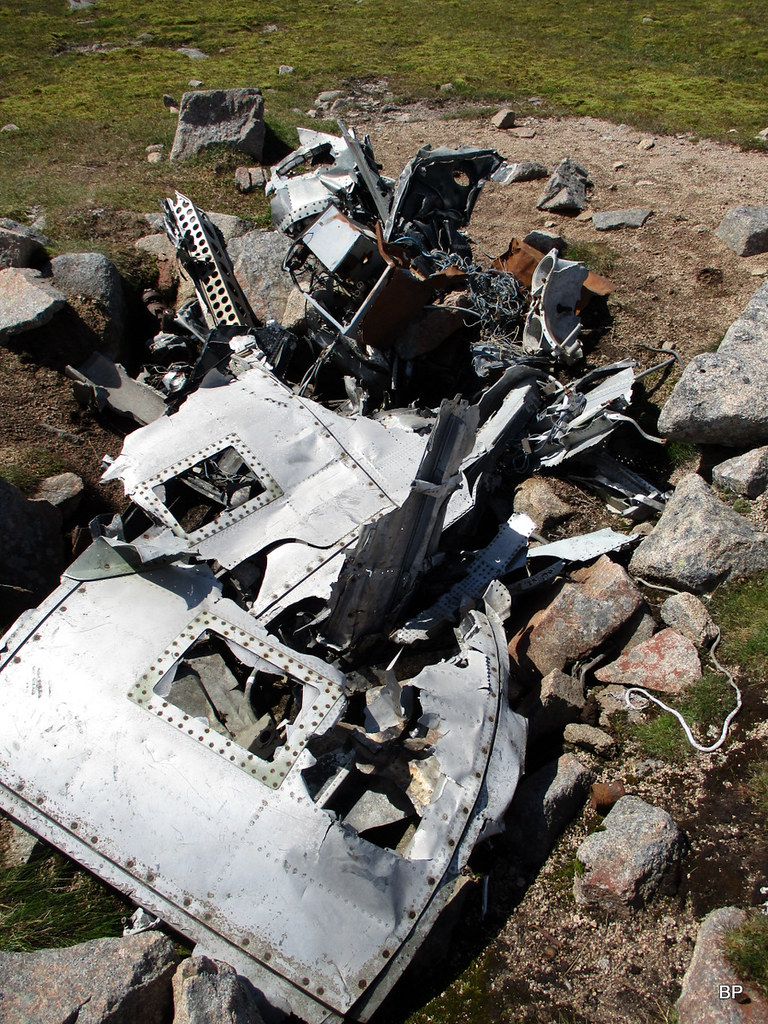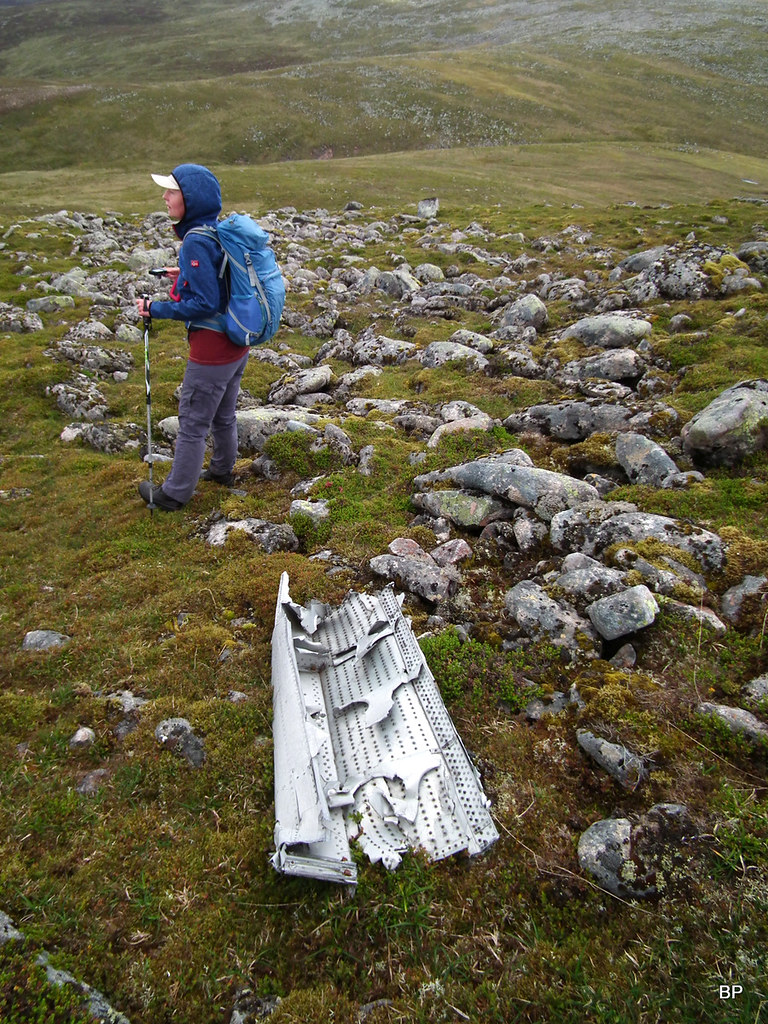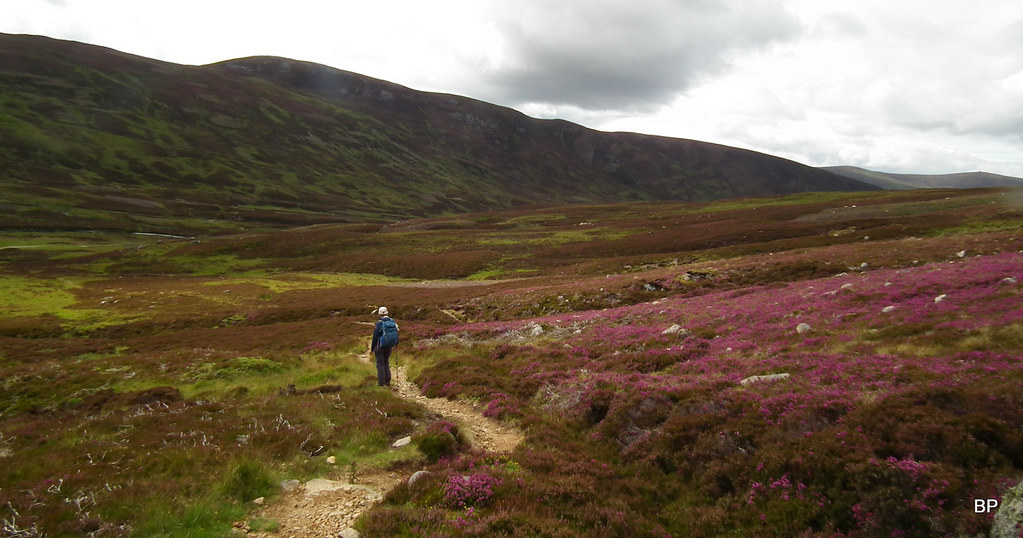free to be able to rate and comment on reports (as well as access 1:25000 mapping).
On the 22nd of November 1956 at 18:02, Canberra B.2 WJ615 (from No.35 Squadron RAF) took off from RAF base in Upwood having been approved for Diversion Practice Training. The plane departed for Kinloss (Scotland) in good weather conditions and good forecast for the whole time of the journey. On board were two crewmen: Flying Officer A.A. Redman (Pilot) and Flying Officer A.A. Mansell (Navigator). At 19.00 the aircraft made radio contact with the base in Kinloss, followed by a standard Controlled Descent through Clouds procedure (QGH1) from 25,000ft (7600m). The Canberra then made a visual circuit and an overshoot of runway 26 was carried out.
At 19.21 hours the plane climbed away from an overshoot height (300ft) as it was reported by Kinloss Air Traffic Control. They contacted the crew and gave them two regional pressure settings. The pilot, FO Redman, answered: "Thank you. Good night."
It was the last message received from the Canberra.
...
The plane was then seen gaining height for its return to Upwood. At about 19.30 several witnesses in the area of Braemar heard the noise of jet engines as the plane passed over the area. They described it as flying "at an unusually low altitude" though the engines sounded normal... Why was the Canberra flying so low, has never been determined.
Only a few minutes later the witness saw a flash of light. The plane struck the high slopes of the nearby mountain, Carn an t-Sagair Mòr.
Today, debris from the Canberra is still scattered around the summit of the Munro. As more and more people started to bag hills as a hobby, this crash site, being so close to the top of one of the Whitemounth M's, also became one of the most known in Scotland. Internet is full of photos of people posing with the wing of the Canberra. Most folks treat it as a little curiosity en route to their next target, but not many give the debris field a closer look. Neither did we, to be honest, the first time we climbed Carn an t-Sagair Mòr (2012). To our excuse, it was in early spring and the summit area was still covered in large patches of snow, so most pieces of wreckage were probably hidden from view. I remember walking past a few metal parts and photographing them. Later I wrote in
my TR:
"I remembered somebody mentioning a plane crash site somewhere near the top of this Munro and I wondered whether we could find any remains. We didn't really do any proper searching, but just as we walked in straight line, we encountered a few small bits of the plane."Me with a piece of wreckage from Canberra B.2 WJ615, March 2012:
Since getting more involved in finding aircrash sites on Scottish hills, I kept reminding Kevin about the lost Canberra from Carn an t-Sagair Mòr. I felt like we hardly scratched the surface with this particular site and internet research proved there is a lot of debris scattered all over the high slopes of the Munro. So when weekend weather forecast suggested better conditions in the east, we knew where we were going.
We used the less obvious approach to Carn an t-Sagair Mòr, via Glen Callater. We had climbed all Whitemounth Munros in the past (in different combinations) so there was no pressure to bag multiple tops, we could concentrate on Carn an t-Sagair Mòr and the crash site only:
Because remains of the Canberra are widely dispersed, we planned to find some on the way up, reach the summit and then search the western side of the mountain. We ended up going up and down several times and still I bet we didn't find it all!
The morning was wet but by the time we drove from Beauly to Braemar it has just stopped raining though low cloud still touched the summits, but we hoped that by the time we climb up Carn an t-Sagair Mòr, it should clear. As for passing showers, we didn't mind them. We are not made of sugar

The car park was already busy but still a few spots to park. It was post-Covid weekend day after all...
The walk-in through Glen Callater takes time but it's such a lovely area that we didn't hurry too much...
We spied the stalker's path climbing up from Lochcallater Lodge and traversing below Creag an Loch. This route offers fantastic views down to Loch Callater:
The southern end of Loch Callater seen from higher up the path:
Not much to say about the climb - the path is very good and the angle not too steep. We noticed another group of walkers behind us but they didn't catch us till we stopped by a small cairn at about 950m. From here, they aimed straight for the summit, we began our careful scanning of the slopes (we had grid refs from several sources, which helped a lot).
Kevin was all smiles today despite his knee still not fully recovered:
South to Carn an Tuirc:
The ground on the western side of Carn an t-Sagair Mòr was easy to search, mostly grass with some scattered rock:
It wasn't long till we stumbled upon the first remains, a hydrolic cylinder of some sort:
 2020-07-25 callater plane crash 191
2020-07-25 callater plane crash 191 by
Kevin Dalziel, on Flickr
I wondered if this was part of the jet engine, the jet pipe perhaps?
 2020-07-25 callater plane crash 039
2020-07-25 callater plane crash 039 by
Kevin Dalziel, on Flickr
Only five minutes later, Kevin spotted a wheel hub:
Next to the wheel, we found two large chunks of aluminum from the main fuselage:
 2020-07-25 callater plane crash 050
2020-07-25 callater plane crash 050 by
Kevin Dalziel, on Flickr
The next piece we came across was a bit surprising - the second wheel still complete with a tyre:
Posing with the wheel, only now I realized how big this plane must have been!
We were now close to the summit and Kevin soon spotted more debris above us:
A partially buried piece of fuselage, most likely the tail plane:
As we emerged on the flat summit area, we found one of the most photographed fragments of this plane, part of one of the jet engines:
Seen from the other side:
Only a few steps from the engine, we spotted a hole in the ground filled with small pieces of debris from the plane. I wondered if this could be the impact crater?...
I'm not even trying to name the mangled debris inside:
 2020-07-25 callater plane crash 239
2020-07-25 callater plane crash 239 by
Kevin Dalziel, on Flickr
Looking south-east from the summit to Cairn Bannoch:
Carn a'Choire Bhoidheach and Lochnagar:
We caught a sunny spell on the summit and enjoyed the views as long as they lasted. Lucy bagged her 127th Munro:
I don't know which of the two cairns is the true summit, but the northern one contains a few pieces of the Canberra:
By the time we finished our lunch, other groups of walkers began to arrive from all directions, so we left the summit in search of more plane parts. Weather was changing and we noticed a shower moving in from the west:
We decided to split to cover more ground. I stumbled upon a small part of fuselage...
...whereas Kevin walked straight towards the largest (and probably the most famous!) piece of the plane known to have been left here:
It's the port wing, still nearly complete with the jet pipe attached:
From the wing, we followed a trail of small bits and pieces to the next larger chunk, the tail rudder:
Next to the tail part, we saw more scattered debris:
As we zigzagged down the northern side of the mountain, we kept coming across more and more pieces of wreckage. We tried to photograph everything we found (not that we'll ever be able to recognize most of it anyway!) but it would be impossible to place all pictures in this TR...
As we continued our search, I tried to imagine the rescue mission in 1956. The recovery team consisted of two RAF Service Mountain Rescue Teams plus about 30 civilian volunteers, guided by Police and Queen's gamekeepers. A helicopter was also engaged. The wreckage was first spotted from the air at 8:40 on the 23 November 1956. Later, some wreckage was recovered to 63 MU RAF Edzell for accident investigation, component recovery and scrapping. But of course, a lot was left behind...
 2020-07-25 callater plane crash 126
2020-07-25 callater plane crash 126 by
Kevin Dalziel, on Flickr
We were descending slowly towards the col between Carn an t-Sagairt Mor and Carn an t-Sagairt Beag, when Kevin spotted another large piece:
This piece has been named elsewhere as a tail section of the plane:
When Kevin investigated the tail section, I followed a trail of small parts...
... to a depression in the ground, filled with more wreckage:
On the wet bottom of the bealach, we found another piece of fuselage, this one partially submerged in bog:
There's more to find lower down, including big chunks of the main fuselage still painted red:
 2020-07-25 callater plane crash 157
2020-07-25 callater plane crash 157 by
Kevin Dalziel, on Flickr
Even today, we still don't know what happened here on that cold November night. The crash was followed by a Court of Inquiry, but it was unable to determine the cause of the accident. Three options were taken under consideration: deliberate low flying, pilot unknowingly low flying or a technical emergency/failure resulting in loss of altitude. The technical problem like a faulty altimeter seems the most likely option but because the crew never reported any issues after sending the "Thank you, good night" message, the truth behind this crash will remain mystery.
We spent more time hopping over bog and taking pictures, but the incoming shower eventually persuaded us it was time to go back down.
We said a quiet "Thank you, good night!" to the ghosts of the lost Canberra and began our return walk.
Descending towards the imminent shower:
Be careful if contouring around the northern side of the hill, there is a section of vertical slabs at some point, better to stay high to avoid them:
A gate to nowhere


Back down in Glen Callater, we were surrounded by flowering heather:
 2020-07-25 callater plane crash 166
2020-07-25 callater plane crash 166 by
Kevin Dalziel, on Flickr
So it was another memorable day on the hills and another lesson in aviation history. I know this wreck is probably one of the most visited in Scotland (even if the majority of visitors just pass by without paying much attention) but I thought it would be interesting to do more research and uncover the true story behind the broken wing so many walkers pose on when doing the Whitemounth circuit.
In our next wreck hunting expedition, we visit one of the most popular Scottish Munros and discover the remains of another lost Avro Anson. TR to come soon

List of sites with information about the Canberra crash site:
https://aviation-safety.net/wikibase/21102https://35squadron.wordpress.com/2017/05/21/canberra-b-2-wj615-22111956/http://www.edwardboyle.com/wreck20.htmlhttps://heavywhalley.wordpress.com/2016/06/20/a-long-day-carn-an-t-sagairt-mor-broad-cairn-and-carn-bannoch-very-tricky-navigation-lessons-learned-thanks-breamar-mrt/